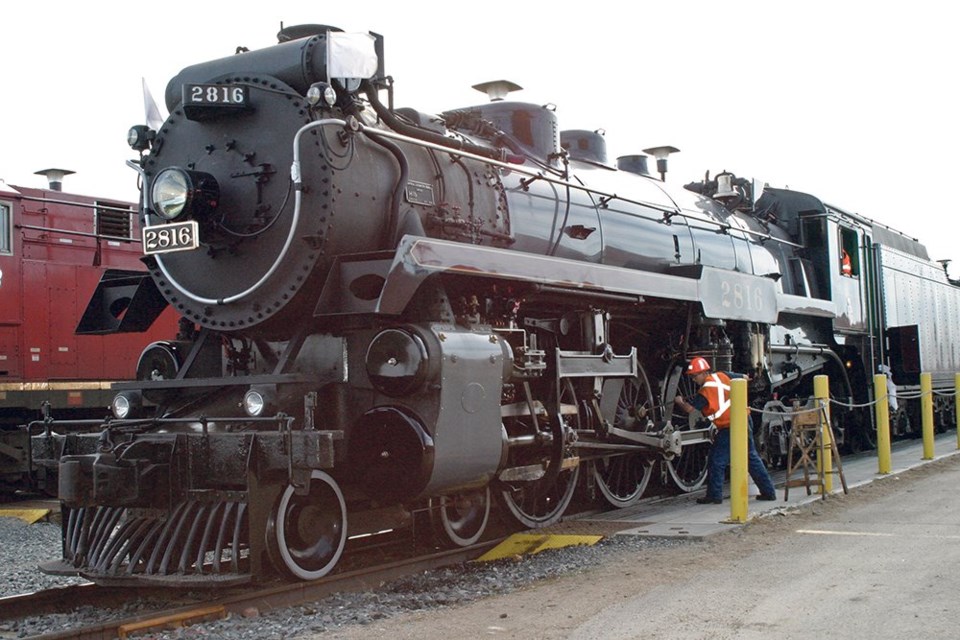WESTERN PRODUCER — The railway tracks ran through the middle of our farm. Every Monday, Wednesday and Friday, I could watch the Canadian National passenger train come huffing and puffing from the east, returning to Winnipeg on alternate days. When it blew its steam whistle at the crossing, Dad sometimes set his pocket watch before tucking it back into the bib pocket of his overalls.
I had the heady experience of riding on the train four or five times as a child. The green velour seats felt soft against my bare legs. I found it a novelty to visit the tiny washroom that smelled sweetly of disinfectant. The portly conductor in his blue uniform seemed to like children.
While I enjoyed the rhythmic motion of the passenger coach as I rode, I hated the threatening sound of the steam engine as the train pulled into town. I was afraid it might one day let off steam prematurely, scalding me to death right where I stood on the station platform. Either that, or it might jump the tracks and run over me, so I cowered behind my mother’s skirt for protection.
When the train came from the east, bringing shipments of groceries and one or two mailbags, the village storekeeper and the postmaster were there to meet it with their wheelbarrows. While waiting for the train, I sometimes sat in the maroon and cream railway station and listened to the Morse code being tapped out by the telegrapher wearing his green visor.
On the wall were pictures of huge ships belonging to the Cunard line, but the possibility of ever sailing overseas was so remote as to generate little interest.
I would go back out on the platform, where a few more people usually gathered, including schoolboys too careless to worry about the truant officer. A couple of mangy dogs sat in our midst, vying for attention from anyone who would give it.
The train chugged into town right on time, dispensing one or two passengers from the coach and unloading its shipment from the baggage car before moving on to the pump house, where a giant spout was lowered to replenish the water for the steam boiler.
When the train came from the west, however, there was seldom anyone to meet it, except for the occasional woman who boarded it to go to the hospital about 25 kilometres away, for the imminent delivery of her baby.
A reliable lifeline to the outside world, the train at one point also became an instrument of death, colliding with a vehicle at the level crossing. One minute we students had been waving to the lone occupant of a car as it passed the schoolyard. The next minute he was dead, his flimsy car reduced to a mangled piece of scrap metal right before our eyes.
Long after the bell rang that afternoon, the unmerciful hissing of the steam engine mingled with the muffled sobs of children who were mourning the loss of a hired man they had come to love.
A policeman came to the school to interview eyewitnesses to the tragedy, and I was relieved when he chose to listen only to the older students. I wanted to put the whole scene out of my mind. I never could.
And then came the great Manitoba flood of 1950. With water inundating much of Winnipeg, even the railway company was moved with compassion, providing free passenger service to points west for those who were being evacuated.
I happened to be on the station platform the day the local station agent posted the notice:
Flood train arriving tomorrow, 7 pm.
Word quickly spread. Chores were done early that evening and trucks, trailers and wagons all converged at the station, prepared to take in the flood victims and their belongings.
Kids and dogs played tag among the vehicles in the cinder parking lot, and women swapped blankets and pillows and eggs in anticipation of spare beds to make and extra mouths to feed. Business boomed in the Red and White store across the road.
At seven sharp we saw the light of the locomotive in the distance. A hush fell over the noisy crowd. Daring boys who were placing pennies on the rails were jerked to safety.
Wheezing and puffing, the train pulled into the station, while toddlers clung to their mothers’ skirts as I had once done and farm collies sought refuge under the platform.
The train came to a stop. Countless questions raced through my mind. What do you talk about with strangers? Will there be any kids my age? What if we don’t have enough room for everyone? What if the accommodations we offer aren’t good enough for city folks?
We waited. There was some sort of delay. Probably with the luggage. Flood victims would naturally take along as much as they could.
At last, the conductor appeared and reached up to offer his assistance. Down the steps of the passenger coach came a little old lady.
The only luggage she carried was a bird cage containing one yellow canary. That was it.
For a moment the crowd stood in stunned silence, their hopes flattened like the boys’ pennies on the railway tracks.
Then Bunion, the town joker, exclaimed, “Well I’ll be jiggered. Just who has a wagon here big enough to carry this canary? Or shall I go hitch up my team of horses?”
Suddenly seeing the humour in the situation, good natured chuckles rippled through the crowd, the farm women joking among themselves as they reclaimed the goods they had exchanged just minutes before.
Every year when I listen to concerns about spring flooding, I remember the faces of those hometown folks gathered on the station platform, their provisions ready, their hearts willing to welcome anyone who came.




